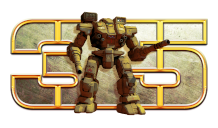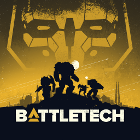- Home
- New To BattleTech?
- MUL
- Forums
- News
- Books
- Shrapnel
- Universe
- Downloads
- Characters
- Community
- Errata
- Links
- Gallery
BattleMech Manual: Final Release
On July 25, 2017
Hi all!
The new BattleMech Manual is now available for purchase, and I thought I’d answer some of the questions arising in the wake of its release.
First: yes, this is the final edition of the book, not the Beta version. It’s PDF-only for now. Thanks to Ray “Adrian Gideon” Arrastia’s tireless work, there will be a limited hardcover print release at GenCon, with a full hardcover print release to follow at some as-yet unspecified date beyond that. We’ll let you know the moment it hits our warehouses and we can be sure of a street date.
So, what is this book? Specifically, how does it relate to Total Warfare and the rest of the current BattleTech line? We heard that question frequently during the Beta, and I wrote a lengthy post on the official BattleTech website detailing the design process:
In short, the BattleMech Manual is NOT a new edition of BattleTech: these are the same basic rules you’ll find in Total Warfare (TW). However, they have been heavily cleaned-up and reworked. These rules cover ‘Mechs only, have been rewritten to be clearer and more concise, include all errata and FAQs, and have been designed specifically for play at the tabletop. Also, there’s a ton of gear from Tactical Operations, some of the optional rules from that book, and bits of Strategic Operations and Interstellar Operations. No construction rules are present. Below is the full BattleMech Manual Table of Contents:
So what’s changed between the Beta and the final? In short, lots. This wasn’t a Beta that simply collected typos and minor glitches (there weren’t a lot of those, but they were fixed, too). I had a full six months to collect feedback from the BattleTech forums and the many other sites on which BT fans congregate, and any regular TW errata that came out in those six months was also included. Mainly though, I spent that time going over the manuscript again and again, looking for ways to trim to the text further, clarify further, and rearrange things to make more sense. The process involved not just correcting errors, but making a lot of quality-of-life improvements as well. The final changelog came to 346 alterations. Some of that was “hey, I see an extra space here,” but there were many, many larger-scale changes as well. I’ll go over a few of them.
The biggest change was in the layout of the Movement chapter. Rulebook design is tricky, since you have to define your target audience first. With the Manual, we were looking to make something for veterans. At the same time, the changes intended to appeal to vets — clearer text, easier-to-find information — are also good for new players, and I hope that those just getting into the game will also find the book useful. The major difference between those two groups is that the new player is more likely to read the book beginning to end: for them, it’s more like a novel, and so should flow in a reasonably logical start-to-finish order. The vet, on the other hand, generally knows the rules of gameplay, and just needs to be able to locate certain rules quickly. They know how to play the game, but might not remember the precise mechanics of spotting for indirect fire, for instance. They’re not looking at it as a novel, but are hopping around all over.
Back to the Movement chapter. I made a lot of alterations from TW when I first wrote it up. Much of this was focused on shifting the odder, less-used movement rules off to other chapters (skidding was moved off to the Urban Combat chapter, for example). However, it was also important to me that those rules flow in a more logical order (as I explained in the blog post linked at the start). When it came to the Jumping rules, I followed the TW example, which was to list all movement modes together and detail them in their entirety there. But during the Beta review I realized that while this choice was logical from a “keep everything together” perspective — the viewpoint of the veteran player, who wants all their stuff in one place — it doesn’t make a lot of sense to the new guy. Jumping offers all sorts of exceptions to the regular movement rules: it’s pretty much just a giant list of ways in which you can break or ignore them. If I want a new BattleTech player to be able to ease their way into movement, that’s not going to happen if they run into a full page at the very start detailing how jumping ignores facing changes, works differently with levels like so, and interacts with water like this, especially when they haven’t reached the regular rules for those things yet. It’s presenting the reader with a list of exceptions to rules they don’t even know yet.
As such, the final version of the Movement chapter has Jumping listed as a movement mode, gives only movement mode information in that section, and leaves the rest of the jumping rules until after the basic movement rules, in a new subsection called Jumping Movement. So it’s still mostly all together, but now a reader learns the rules in a more understandable progression.
Beta on the left, final on the right.
Other parts of that chapter were overhauled, too. A lot of the movement basics were re-ordered to be more logical. In the Beta, I had the progression as: a section called Movement Between Hexes (which had some terrain info), then a Level Change section (terrain), and then a Stacked Terrain section (terrain…). Now there’s a much simpler Ground Movement section, and terrain and levels are dealt with in a separate new Terrain section.
Readers will find changes like that throughout the book. To give just one other quick example, the Beta’s Combat chapter had an Attack Declaration section that more or less repeated rules the reader had just read but left out some important info: when exactly do you declare specialized attacks? That’s been fixed.
Many, many clarifications were also made. For example, displacement is an innately tricky issue, in that it involves movement, damage, and a host of potentially weird timing issues. A very fruitful discussion on the Beta feedback thread at the official BattleTech forums brought up all sorts of questions over the course of several pages. Several drafts and re-writes later, the section has doubled in size, but is much easier to follow. The general goal with the Manual was “less is more” — and a great deal of text was trimmed throughout the book — but that went out the window if a higher word count was actually needed.
Everything in yellow was rewritten, so … everything. There were numerous pages like this.
Skidding was a big one. I’m not really a fan of these rules, but if they had to be there (and they did, because this isn’t a new edition), then I wanted them to be as clean as possible. The Beta broke Skidding up into more manageable chunks, but going over that section again, I felt I could do better. So the final version breaks up the Collisions section further (into Collisions with ‘Mechs and Collisions with Stationary Objects), and clarifies the examples with regards to all the displacement stuff that occurs as a result. A good four pages of text was completely replaced here.
Quirks were also heavily redone. They were added to the Manual in the first place as the result of fan feedback, and we received a lot of corrections and suggestions on the quirk list during the Beta period. Many ‘Mechs have received new quirks, or have had inappropriate ones taken away, and we added a few ‘Mechs we missed in the first place. Lastly, the quirks themselves were edited to make them clearer and more playable, one was deleted (Rumble Seat, which bestowed a capability that TechManual said all ‘Mechs already have), and one all-new quirk was added (Ramshackle, for all your Periphery and Third Succession War-era needs).
Lastly, there was the weapons chapter. Some excellent feedback on the forums pointed out that a lot of the ‘Mechs in the most recent Technical Readouts had equipment the Manual didn’t include rules for. Now, the Manual was never intended to include everything: “95% of what 95% of players need” was the mantra. But with those new TROs using so much cutting-edge gear, we were definitely falling behind that 95% figure. You can read more about the thinking around this issue here.
In short, gameplay rules for the following new pieces of equipment were added to the final:
- AES
- Armoured components
- Ballistic-reinforced armour
- Boosted C3
- Ferro-lamellor armour
- Hardened armour
- Lance
- Partial wing
- Re-engineered lasers
- Reflective armour
- Talons
- Vibroblade
- XXL engine
And of course I went back through the book and added references to all these items in the appropriate standard rules sections. For example, both the Heat and Movement sections now detail XXL engine effects, the Club section now mentions the additional modifiers applied when you try to use a club with claws, etc. And then Chris Hart, writer of so many of those well-received bits of flavour text on all the weapon entries, added some fun new ones to it all.
I hope all of this has helped show just how much the Beta process changed things, and why it’s worth upgrading your copy to the final version. The BattleMech Manual gives you the clearest, easiest to follow, most thoroughly-pored-over set of ‘Mech rules we’ve ever had, excellent regardless of whether you play in 2450, 3025, 3150 or any era in between. Thanks to everyone that contributed feedback, and I hope you have a ton of fun with it.
— Keith Hann












